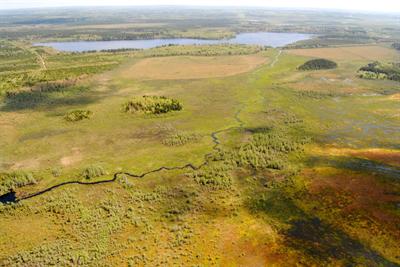 Chignecto Isthmus Wilderness Area protects about 3,750 hectares of wetlands and conifer and mixed forest at Chignecto Isthmus, where Nova Scotia is connected to New Brunswick and all the Americas. Expansion of this wilderness area in 2017 nearly quadrupled its size.
Chignecto Isthmus Wilderness Area protects about 3,750 hectares of wetlands and conifer and mixed forest at Chignecto Isthmus, where Nova Scotia is connected to New Brunswick and all the Americas. Expansion of this wilderness area in 2017 nearly quadrupled its size.
The original wilderness area was designated in 2008 on lands owned by the nearby Town of Amherst. The Town requested this protection to better safeguard the groundwater recharge area for its drinking water supply wellfield. The expanded wilderness area extends protection to more of the groundwater recharge area and the Town’s North Tyndal Protected Water Area. The Protected Water Area designation regulates activities such as vehicle use, fires, forestry, and other land uses. For more information on the North Tyndal Protected Water Area please contact the Town of Amherst.
Chignecto Isthmus is a critical land bridge to the rest of North America. Maintaining a natural corridor here enables continued movement of species in and out of Nova Scotia. Recognizing this, the Nature Conservancy of Canada (NCC) has acquired and conserved over 1,000 hectares of land on the Isthmus in recent years, including in-held properties within the wilderness area (Missaguash Bog Conservation Lands). NCC has raised the public profile of the corridor through its “Moose Sex Project” campaign. Moose that wander across the border from New Brunswick are believed to help sustain the endangered moose population on mainland Nova Scotia. There is also evidence that Canada lynx have used the corridor.
Lands near the border of New Brunswick consist almost entirely of an expansive fen-bog complex, which provides habitat for several uncommon plant species. Lands at the eastern end of the addition include better drained areas with conifer and mixed forest at various stages of regeneration following forest harvesting.
This wilderness area provides good representation of the Northumberland Strait Plain natural landscape in the provincial protected areas network.
Managed wetlands on Crown land to the west are not part of the wilderness area. Lands in this area were acquired to create and maintain conditions for waterfowl production. Using water control structures and other means, they have been managed for this purpose by Ducks Unlimited for more than 50 years.
The Chignecto Ship Railway corridor bisects the area but is not part of the wilderness area. A forest access road from Route 366 (Tyndal Road) to the Ship Railway and Long Lake is also not part of the wilderness area. Both the Ship Railway and Long Lake Road are part of the regional off-highway vehicle (OHV) network, and Long Lake Road is used for public access to Long Lake by vehicle.
Several sections of the regional off-highway vehicle (OHV) network pass through the wilderness area. An 800m section of trail bypasses a wet section of the Ship Railway, and a 1.8 km section of trail connects to New Brunswick along the Maritimes and Northeast pipeline corridor. On-going use and management of these trails is permitted under agreements with the Snowmobilers Association of Nova Scotia (SANS) and All-terrain Vehicle Association of Nova Scotia. Bicycle use is also permitted on these trails.
The wilderness area surrounds a number of private properties. If needed, access to such in-held properties can be authorized by the Minister of Environment.
Several campsite leases and a lease with Scouts Canada at Long Lake are located within the wilderness area.
About 2.6 km of electrical transmission line right-of-way passes through the wilderness area, south of Long Lake. Nova Scotia Power (NSPI) retains the authority to operate and maintain this transmission line.
A 1.8 km section of the Maritimes and Northeast (M&NE) natural gas pipeline passes through the northern portion of the addition. M&NE retains the authority to operate and maintain this pipeline.
Designation Documents - Town of Amherst Lands (2008)
- Map of Town of Amherst lands designated as wilderness area in 2008

- Read the government news release (December 11, 2008)

